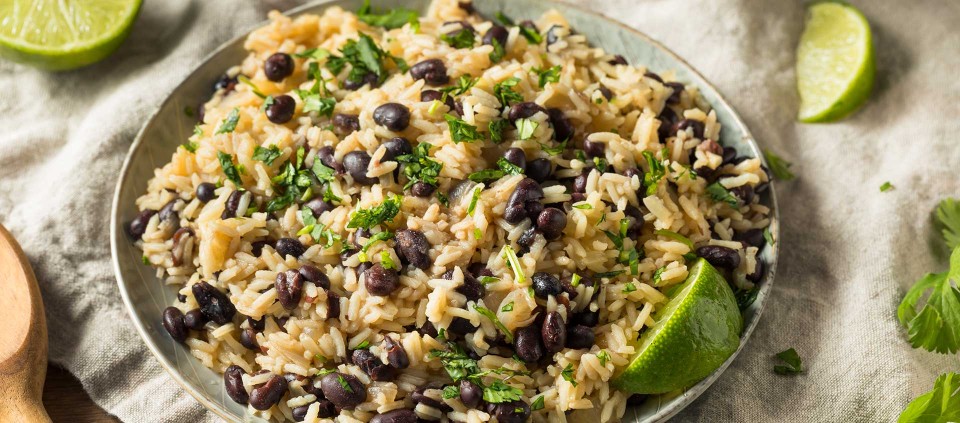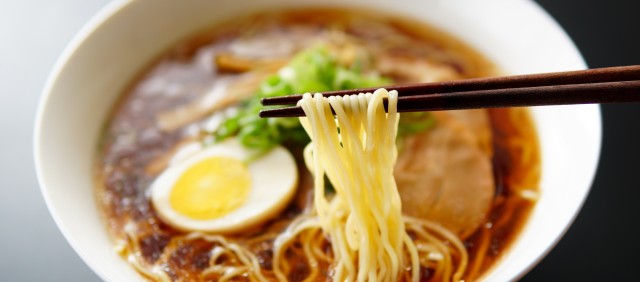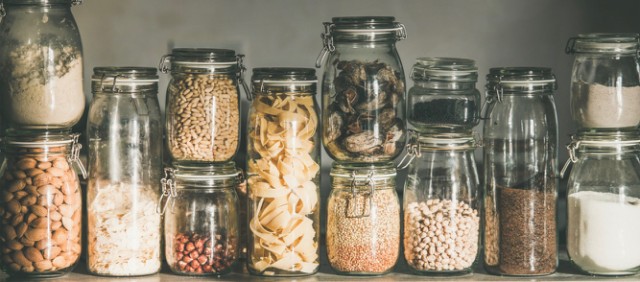How to Make Rice and Beans More Fun

April 15, 2020
Frequent trips to the grocery store are just not the best idea right now, as we all well know. If your cupboard is starting to look a little bare, this might be a good time to get creative with some trusty staples: rice and beans. Fortunately, there are lots of ways to make this basic staple more fun.
Since none of us are likely to be doing any actual traveling for quite some time, how about taking a little journey around the world in our own kitchens as we explore some exciting, flavorful, international versions of this humble meal? Also, might I add that if you have avoided eating beans in the past due to their dubious reputation as the “musical fruit,” now may be the perfect time to partake. Since you aren’t likely to be having any dinner guests for a while, you can go ahead and eat all the beans you want without fear of the consequences!
Here are 10 suggestions for getting creative with your rice and beans:
Gallo Pinto
Our first stop on this culinary journey is Central America, where we will enjoy a taste of gallo pinto, the most ubiquitous dish in Nicaragua. Gallo pinto can be translated as “speckled rooster” because of the speckled appearance of the red beans and the rice. This dish is extremely versatile—good for breakfast, lunch, or dinner. It’s often served with fried plantains, and is great with other sides, such as meat, fish, cheese, eggs, and/or a chopped cabbage and tomato slaw. Here’s a good recipe.
Cuban Frijoles Negros
Next stop: Havana! Writes Kripalu Yoga teacher Miriam Bradman Abrams, “I love my Cuban frijoles negros con arroz [black beans with rice]. Use lots of garlic, cumin, oregano, white wine, and vinegar while simmering, and add cilantro to jazz it up.” Be sure to listen to some energizing Cuban music while cooking!
Coconut Rice and Beans
Looking to enjoy a bit more island time? Here’s a riff on a Jamaican favorite. It involves either Caribbean red beans or kidney beans, plus basmati rice, coconut milk, and spices. Yum!
Coconut Milk Rice and Beans, Dessert Version
In many parts of East and Southeast Asia, beans are often used in making sweet desserts. Red bean ice cream in China and Thai mung bean and coconut rice pudding are some unexpectedly delicious examples. For an Asian-inspired sweet bean treat, try combining warm coconut milk with cooked mung beans, white rice (jasmine, if you’ve got it), and your favorite sweetener. This can also work well with adzuki beans or even black beans.
Thai Mung Bean Coconut Curry
Moving on to Southeast Asia, we’ll continue to explore ways to dress up our rice and beans with coconut milk. There are many wonderful recipes available online for Thai mung bean coconut curries. Here’s a simple, quarantine-friendly version that doesn’t require a lot of fresh ingredients. Imagine yourself enjoying it on a perfect Southeast Asian beach at sunset ...
Edamame and Quinoa
Touch down in Japan and pick up some edamame. You can find shelled edamame in the frozen food section of many grocery stores. Edamame cooks quickly and is delicious either warm or cold, served with quinoa or brown rice and a simple dressing of olive oil, garlic, lemon juice, and a little pepper. Also great with a bit of chopped kale, red pepper, avocado, or even wild rice thrown in if your cupboard is still abundant.
Kitchari
Moving on to India, we will sample kitchari, a simple, nourishing dish that is traditionally made with white basmati rice, yellow mung beans, ghee, and a mix of spices that often includes turmeric, coriander, and cumin. The classical Ayurveda texts wax eloquent about the healing properties of this simple, easy-to-digest food. There are a plethora of kitchari recipes available online and in Ayurvedic cookbooks. These recipes may involve different types of lentils (red lentil kitchari is particularly yummy) and various combinations of spices, and sometimes include seasonal vegetables. Here’s Kripalu’s house recipe.
Breakfast Kitchari
Follow the basic kitchari recipe, but substitute cinnamon, ginger, and cardamom (half as much cardamom as the other two spices), and cook with some chopped apple. This recipe is adapted from Kripalu faculty Kate O’Donnell’s The Everyday Ayurveda Cookbook.
Vegetable Biryani
More Indian-inspired yumminess from the Kripalu Kitchen! Biryani is a popular rice dish that includes cashews, raisins, and spices, including turmeric, which gives it a lovely yellow color. You can omit the saffron and cilantro in this recipe if you don’t have those on hand.
Cumin Rice
Here’s another popular way of preparing rice in India. Fry some cumin seeds in ghee or coconut oil. Add your desired quantity of white basmati rice. Double the quantity of water to the pot and cook for about 20 minutes. Enjoy!
Get more recipes, plus yoga classes, Ayurveda, and more:
Give Sprouting a Try
This can be really fun, especially if you have some extra time on your hands. If you’re new to sprouting, I recommend starting with either brown lentils or whole green mung beans. If you’d like to sprout rice, try brown rice. Split lentils and white rice will not work. Sprouting may increase the content of protein and other nutrients in the food; sprouted rice and beans also require less cooking time. You’ll need a glass container, such as a 1-quart mason jar—I once used the carafe of a glass French press. You’ll also need a piece of thin cloth (cheesecloth or an old T-shirt will both work) and a rubber band.
Place a half a cup of rice or beans in the container, cover it with lukewarm water, cover the top of the container with the cloth, secure with a rubber band, and let it sit for 24 hours. Then rinse, drain, and place the container on its side, out of direct sunlight. Continue to rinse and drain, morning and evening, until you see the rice or beans begin to crack open and sprout little tails. This process usually takes two to four days. It’s safer to cook your homemade sprouts rather than eating them raw.
Lemon Rice
Add lemon juice to the water while cooking the rice, then add a bit of lemon zest to the cooked rice along with a little dried dill or parsley. This is also really good with chopped arugula, when you have access to fresh greens. This approach is courtesy of my former Kripalu colleague Elizabeth Walz.
Cauliflower Rice and Lima Beans
If you’re looking for something that you can freeze in order to minimize trips to the supermarket, here is a recipe that is both gluten-free and relatively low-carb. Take a head of cauliflower and grate it to make the rice. (It freezes well.) Cook it up in a little butter, ghee, or the oil of your choice, add some salt and pepper, and sauté it with the thawed-out baby lima beans. Also great with red pepper or any other frozen veggies you may have on hand. Courtesy of former Kripalu volunteer Lynsey Landry.
Bethany’s Black Beans
Yoga teacher and bodyworker Bethany Boulger writes from Hawaii: “Sauté garlic and onions, add black beans, cumin, paprika, cayenne, and cinnamon. Cook on low heat to blend flavors. Add apple cider vinegar and honey, and cook another minute. YUM!!”
Black Bean Brownies
Yes, this is actually a thing! We all know that chocolate makes everything better. This one is courtesy of Berkshire-based culinary nutritionist Emily Paskus.
1 15-ounce can unsalted black beans, thoroughly rinsed and drained (about 1¾ cups)
2 large eggs; for a vegan version, you will need 2 tablespoons flaxseed meal
3 tablespoons coconut oil, melted
¾ cup cocoa powder
1½ teaspoons baking powder
½ teaspoon salt
1 teaspoon pure vanilla extract
½ cup raw sugar, subgranulated or finely ground in a food processor
¼ cup semisweet chocolate chips
Preheat oven to 350 degrees and lightly grease a 12-slot standard-size muffin pan.
Prepare “flax egg” by combining flax and 5 tablespoons water in the bowl of the food processor. Pulse a couple times and then let rest for a few minutes.
Add remaining ingredients besides chocolate chips, and puree for about 3 minutes, scraping down sides of the bowl as needed. You want it pretty smooth.
If the batter appears too thick, add a tablespoon or two of water or almond milk and pulse again. It should be slightly less thick than chocolate frosting but not at all runny. Mix in chocolate chips.
Evenly distribute the batter into the muffin tin and smooth the tops with a spoon or your finger.
Bake for about 25 minutes, or until the tops are dry and the edges start to pull away from the sides.
Remove from oven and let cool for 20–30 minutes before removing from pan. They will be tender, so remove gently with a butter knife or fork. The insides are meant to be very fudgy, so don’t be concerned if they seem too moist—that’s the point.
Store in an airtight container for up to a few days. Refrigerate to keep longer.
Boston Baked Beans
Our rice and beans journey comes to a close with a Massachusetts favorite that never fails to impress. There isn’t really any rice involved here, as this dish is often served with brown bread (a hearty, yeast-free bread that was traditionally steamed inside of a coffee can). Here is my family recipe (thanks, Mom!):
2 cups navy beans, small white beans or Great Northern beans
1 teaspoon salt
¼ pound salt pork
1 white or yellow onion, diced (optional)
2 teaspoons dry mustard
5 tablespoons dark brown sugar
6 tablespoons molasses
Wash the beans and soak overnight. Add salt, stir, and drain, reserving the liquid.
Preheat the oven to 250 degrees. Cut off a third of the salt pork and place the piece in the bottom of the bean pot. Add the beans and the onion (if using) to the pot.
Blend the mustard, brown sugar, and molasses with 2 cups of the reserved bean liquid and pour over the beans. Save the rest of the bean liquid, so you can add some in if the beans dry out while cooking. Cut several gashes in the remaining piece of salt pork and place on top of the beans.
Cover and bake for about seven hours, adding water as needed. Uncover for the final hour of cooking, so the pork will become brown and crisp. Taste and correct seasoning.
If you’d prefer to make a vegetarian version with less sugar, here is a great recipe.
(Bonus: If you’d like to try making Boston Brown Bread, here is a classic recipe. If you don’t have a coffee can around, you can bake this bread in a loaf pan. If you don’t have buttermilk on hand, you can find instructions online for how to easily make a substitute using regular milk and a lemon.)
How to Banish Flatulence
Here are some helpful tips from Kripalu Healing Arts Ayurvedic practitioner Sharon Pollock on how to banish flatulence from your bean experience: “Wash the beans with baking soda and rinse well. Soak overnight or bring to a boil and soak for an hour. Throw out the soaking water. Cook with hing (asafoetida), turmeric, black pepper, and bay leaf.” Sharon’s promise to you: No farts!
Now that we’ve completed our journey, just a reminder that while we might consider rice and beans to be a hardship meal, it is actually a staple for many people around the world who don’t have access to much else, even in the best of times. So, before you tuck into your next bowlful, I invite you to pause for a moment and reflect on the relative privilege and abundance that many of us in the Western world do enjoy, even in the midst of these difficult times. Consider that a temporary period of simplicity at the dinner table might actually be life enhancing if it inspires a greater appreciation for the many blessings in your life. After all, everything tastes better when you add a pinch of gratitude!
Katie Hagel, RYT-500, is a certified Nature and Forest Therapy Guide, Ayurvedic Health Counselor, and Kripalu Yoga teacher.
Full Bio and Programs

